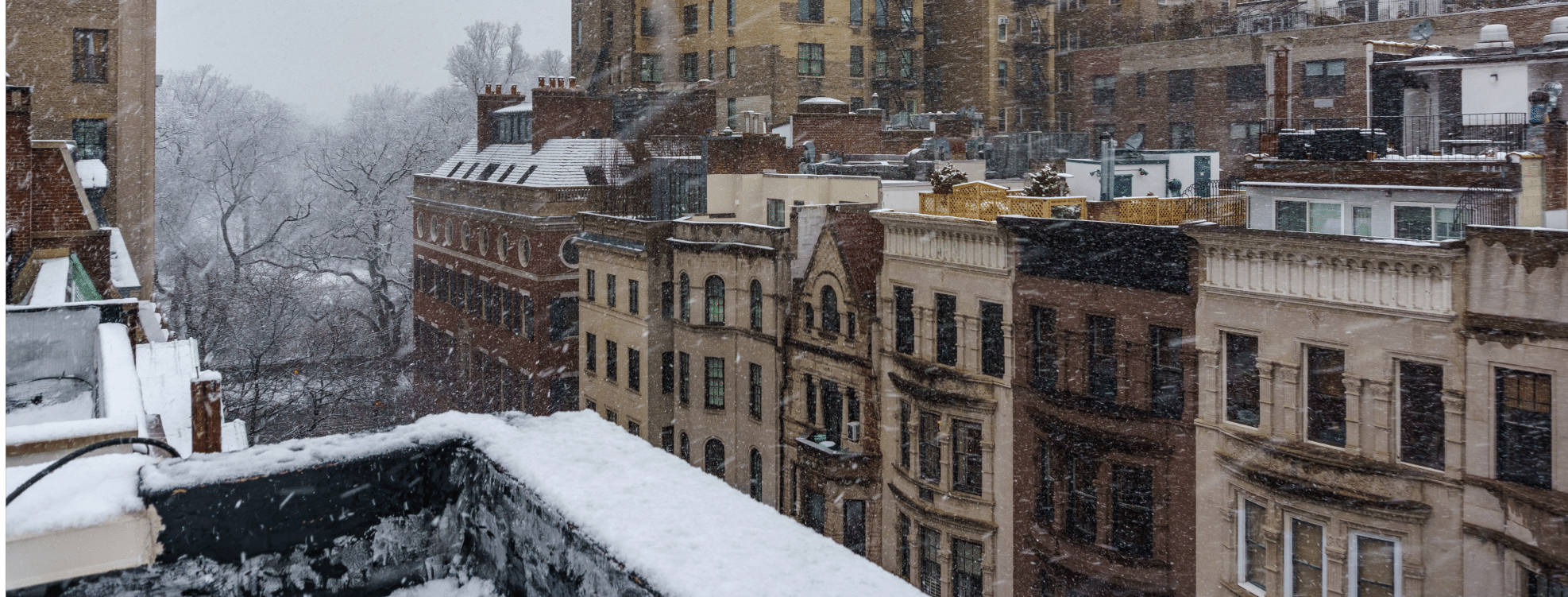If you live in New York City, winterizing a home should be no stranger to you. But for some, it’s easy to forget about the essentials when there’s not much damage year after year. Still, neglecting the basics – or outright ignoring them – will ultimately come back to bite you when a severe winter storm hits the city. That’s why NYC terrace homeowners like you should always be vigilant and stay on top of preparing your home to stand up to bitter wind chills, heavy snowfalls, and ice.
So, with that in mind, here’s a list of eight winterization tips for NYC terraced homes and apartments to remind you what to do before it’s too late.
- Always make sure the gasket seal and bottom door sill is adequately installed. Should there be heavy rain or gusts of wind, the combination of the two will leave your interior space feeling drafty and wet. A poorly installed door can cause an owner lots of aggravation should there be a need to replace interior finishes. Always check egress functionality and construction.
Terrace parapet walls should be—at an absolute minimum—48″ high. Always make sure the walls are structurally sound, whether made of glass, concrete, or metal. Do not lean against terrace walls.
Your terrace should weep! Not because it’s feeling sad, but because adequate drainage is necessary in order to prevent water from pooling/collecting. The floor surface should be pitched to a low point, which will collect water and drain it off.

Honestly, it doesn’t take much effort to properly winterize a home, even a property with a large terrace and plenty of outdoor furniture. The main challenge is planning ahead without rushing preparations to completion as a storm bears down on the region.At a minimum, winterizing a terraced home in NYC should include the following:
- Clean pipes and gutters
- Clean the outdoor grill if you have one
- Store outdoor furniture cushions properly
- Check seals around windows and doors for last year’s damage
- Blowout irrigation systems
- Clean AC filters or have them serviced
- Add more lighting
- Shelter plants from the elements
Here’s a closer look at each tip to give you a better idea of what to do first.
1 – Clean pipes and gutters
The first thing to do is make sure to clean pipes and gutters all the way. One of the biggest mistakes homeowners make is assuming that lines and gutters are clean enough to work well in winter. The problem is that once they find out that they’re wrong, it’s too late to do anything about it. So what’s the worst that can happen if you forget about cleaning pipes and gutters ahead of time? Honestly, the worst thing that could happen is that the whole system – the gutters and everything attached to them – could detach and fall to the ground. The reasons are many, yet the gist is that channels tend to clog over time with refuse like mud and twigs. If you don’t clean out gutters periodically, water from melting snow and ice will eventually have nowhere to go but spillover. When that happens, the entire system could start to collapse and fall away from the wall due to the sheer amount of force trying to push water through the clogged gutter. That said, what’s the bigger hassle? Is it taking 15 to 20 minutes out of your day to unclog pipes and gutters, or is it better to replace the entire system once it’s already on the ground in pieces? If you live in NYC, you already know the answer, so start cleaning your pipes and gutters today before it’s too late.
2 – Clean the outdoor grill if you have one
One of the best parts about owning a home with a large terrace is that you can entertain guests outside or relax outdoors after a long day at work. That’s why having an outdoor grill is a popular amenity for homeowners of terraced properties. An outdoor grill keeps your kitchen relatively clean, and a gas grill is usually much easier to take care of maintenance-wise – if you keep up with it, that is. Over time, many things can start to break down inside the grill and in the critical components like the gas line. For instance, there’s always a build-up of char inside of the grill, and if you don’t clean it out, it’ll make your food taste strange and charcoal-like. Not surprisingly, that same build-up of gunk can start to form on every surface, including the outside of the grill, when it gets bad. So what’s the trouble? During winter, if you wait to try to clean your grill, all of that leftover residue will be caked onto surfaces, and good luck trying to get it all off by hand. On the other hand, residue build-up is less of an issue for stainless steel gas grills, but you still have to clean them periodically, especially before harsh weather strikes. Another part of the grill to check is the valves and hoses that carry propane through the system. Residue and gunk can build up there as well, and it’s actually the most detrimental. If there’s a problem with gas fittings and valves, not only will the grill not work right, but it’ll also be a fire hazard or worse.
If you don’t have a grill on your terrace, but want one discover which grills are permitted on your terrace here.
3 – Store outdoor furniture cushions properly
Another common mishap is to leave outdoor furniture cushions outside the entire winter as if they’re indestructible. They’re not. Without a doubt, furniture designed for outdoor spaces can take a beating during a rainstorm and come out OK in the end. All you have to do is wait for the cushions to dry out, and everything is kosher. But when winterizing your terrace’s furniture, always remember to store outdoor cushions properly before it starts to snow. For starters, you should always keep furniture cushions covered if you don’t have the room to store them in a cool, dry space. It’s also a good idea to make sure that the cushions don’t touch the ground when you stow them away. Typically, outdoor furniture can take a pounding in the elements, but all of it eventually starts to break down through ordinary wear and tear. Along those lines, pests are another concern you should keep in mind because they can burrow into tears in the cushion’s fabric and set up shop for the entire winter season. That’s the main reason you have to store outdoor cushions the right way; the materials will start to break down and tear apart, and you’ll eventually have to replace the entire furniture set if the damage is too extensive.
4 – Check seals around windows and doors for last year’s damage
Of course, you should always check the seals around the home’s windows and doors, especially areas of the house that face the direction of the wind.It’s a standard winterization procedure that most NYC terraced homeowners do; they just don’t do it often enough or do a poor job checking the seals. It takes more than giving window and door seals the eyeball test and assuming that they’re OK for the winter. There could be damage to the seals you can’t see until frost begins to peel away the strip from the frame. The difficulty is that it’s not easy to tell when a seal is chipping away until it’s too late. All it takes is one good freeze to rip window and door seals that already have damage. Similarly, if you have a sliding terrace door, checking your seal is even more critical since sliding doors are notorious for air leaks no matter which part of the country you call home. After all, neither a furnace nor a central air conditioning system can work at tip-top shape if the home isn’t sealed correctly. At worst, poorly sealed windows and doors can actually raise energy costs since the heating and cooling system has to work harder to keep a steady temperature in the home.
5 – Blowout irrigation systems
An outdoor grill in a terraced home gives it character, but having a lush, overflowing garden gives it a soul. In fact, that’s what draws in many homeowners who choose a terraced floor plan. Indeed, some of the most beautiful terraces in the city are full of succulents, vegetable gardens, herbs, and flowers. If you’ve never seen one, they’re absolutely to die for. But how do you get all of those sensitive plants to survive a New York winter? The answer is always to make sure to blow out your irrigation system if you have one installed. Many of us simply don’t have the time to care for dozens of plants throughout the day, especially if each one needs different amounts of water and sunlight. That’s where an irrigation system comes into play, but just like gutters and grills, critical components can start to break down, clog, and crack open. Really, irrigation systems are most sensitive to winter because you don’t want your plants’ life-giving sustenance to freeze for several days on end. Even the best irrigation systems can have cracked pipes, which freeze and cause chunks of ice to backflow into the assembly, eventually ruining the whole thing. If that happens, you’ll probably have to replace the entire system, but you could get lucky, too, and not need a wholesale replacement. Either way, it won’t be a problem if you blow out your irrigation system ahead of time.
6 – Clean AC filters or have them serviced
Along those lines, if you have hoses and fittings in your AC system that break down, the entire unit can go down with it. The good news is that air conditioning systems, particularly central AC systems, are modular and may not require replacing the whole thing. Besides, the best way to make sure that never happens in the first place is always to clean out your AC filters or install new ones if you have that kind of HVAC system. Also, you may not use your AC unit very much during the spring and fall, which sounds like a good thing at a glance, yet there’s a catch. When any machine lies dormant and unused for extended periods, components can start to rust and degrade for a number of reasons. It may seem counter-intuitive to get your AC system looked at during the winter, but it’s actually a great idea before any damage occurs. That way, you can quickly tell what needs fixing right now and what you can wait to repair when the weather warms up.
7 – Add new lighting
Adding new lighting is another tip that may not occur to you, so why do it? The answers relate primarily to safety, but there’s something to be said for ambiance as well. Without a well-lit terrace, it’ll be difficult to see where damage has occurred or where ice has accumulated. Both of which are safety hazards during winter. But an easy seasonal solution is to add portable LED lights around the terrace to brighten up the environment when there isn’t much sunlight in winter. Best of all, new LED lighting can save you money on energy costs during winter.
8 – Shelter plants from the elements
The last step is usually where most homeowners start: sheltering plants from the elements like snow and ice. Some plant species are more sensitive to cold temperatures, but others can handle the seasonal shift. That’s why low-maintenance plants work well for terraced homes in NYC because you don’t need to jump through hoops to take care of them. If you blow out your irrigation system well before winter weather strikes, it’ll be easier to care for the plants that may not survive the season. For instance, you could turn off your irrigation system entirely if you have flowers and herbs in your garden and water them manually for a few months. But always remember that sensitive plants need to be covered before they accumulate frost. You’d be surprised how well a plant can stand up to winter weather if you prepare beforehand. Overall, if you follow those simple tips, you’ll ultimately get more life out of your terrace by not having to do a lot of maintenance every year.
Click to learn more tips from The Terrace Experts.



